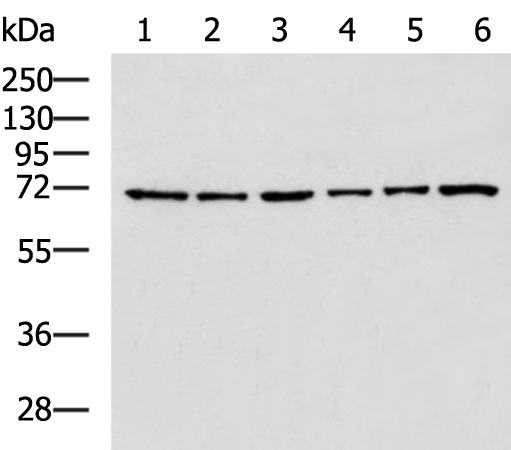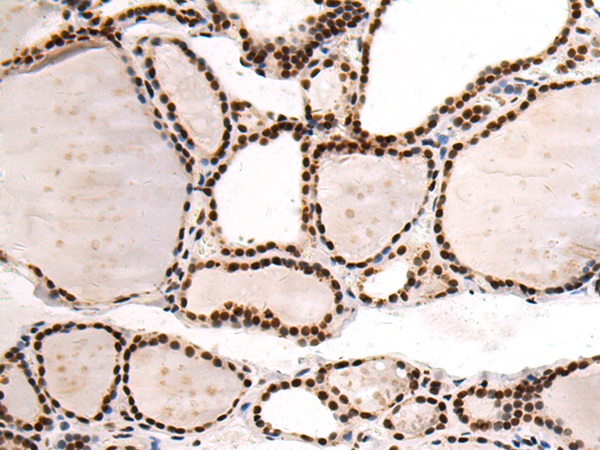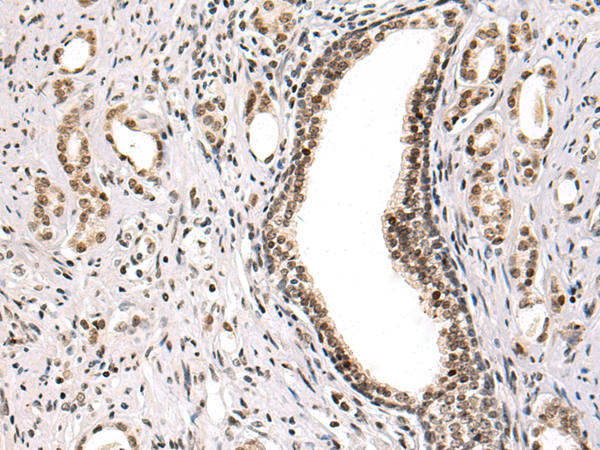


| WB | 咨询技术 | Human,Mouse,Rat |
| IF | 咨询技术 | Human,Mouse,Rat |
| IHC | 1/50-1/200 | Human,Mouse,Rat |
| ICC | 技术咨询 | Human,Mouse,Rat |
| FCM | 咨询技术 | Human,Mouse,Rat |
| Elisa | 1/5000-1/10000 | Human,Mouse,Rat |
| Aliases | CCDC99 |
| WB Predicted band size | 70 kDa |
| Host/Isotype | Rabbit IgG |
| Antibody Type | Primary antibody |
| Storage | Store at 4°C short term. Aliquot and store at -20°C long term. Avoid freeze/thaw cycles. |
| Species Reactivity | Human, Mouse |
| Immunogen | Fusion protein of human SPDL1 |
| Formulation | Purified antibody in PBS with 0.05% sodium azide and 50% glycerol. |
+ +
以下是关于SPDL1抗体的3篇代表性文献的简要总结:
---
1. **文献名称**:*SPDL1 regulates cell cycle progression by modulating the stability of Cdc20*
**作者**:Zhang Y, et al.
**摘要**:本研究利用SPDL1特异性抗体,发现该蛋白通过与Cdc20结合调控后期促进复合体(APC/C)的活性,从而影响细胞周期进程。抗体实验显示SPDL1缺失导致染色体分离异常,提示其在有丝分裂中的关键作用。
---
2. **文献名称**:*Development of a monoclonal antibody against SPDL1 for cancer biomarker studies*
**作者**:Tanaka K, et al.
**摘要**:团队开发了一种高特异性抗SPDL1单克隆抗体,并通过免疫组化验证其在多种癌症组织中的表达上调。研究表明,SPDL1高表达与乳腺癌患者预后不良相关,可能作为潜在的癌症诊断标志物。
---
3. **文献名称**:*SPDL1 interacts with Mad1 to ensure mitotic checkpoint fidelity*
**作者**:Wang L, et al.
**摘要**:通过SPDL1抗体的免疫共沉淀(Co-IP)实验,发现其与Mad1蛋白形成复合物,维持纺锤体检查点的功能。研究揭示了SPDL1在防止非整倍体中的机制,为靶向治疗提供新思路。
---
**备注**:SPDL1(Sperm Antigen with Calponin Homology and Coiled-Coil Domains 1)主要参与细胞周期调控,尤其在染色体分离和检查点信号中起关键作用。相关抗体研究多聚焦于其在癌症及基因组稳定性中的功能。建议通过PubMed或Web of Science以“SPDL1 antibody”为关键词获取最新文献。
SPDL1 (Spindle Apparatus Coiled-Coil Domain Protein 1), also known as CCDC99. is a critical component of the spindle assembly checkpoint (SAC), a surveillance mechanism ensuring accurate chromosome segregation during mitosis. It localizes to the spindle midzone and plays a role in maintaining genomic stability by regulating the timing of anaphase onset. SPDL1 interacts with key SAC proteins, including MAD2 and the dynein motor complex, facilitating the removal of checkpoint signals from kinetochores once chromosomes achieve proper attachment. Dysregulation of SPDL1 is linked to mitotic errors, chromosomal instability, and carcinogenesis, making it a potential biomarker or therapeutic target in cancers.
SPDL1 antibodies are essential tools for studying its expression, localization, and function in cell cycle regulation. These antibodies are widely used in techniques like Western blotting, immunofluorescence, and immunohistochemistry to investigate SPDL1’s role in mitotic progression, SAC signaling, and its association with tumorigenesis. Recent studies explore SPDL1’s overexpression in certain cancers (e.g., hepatocellular carcinoma) and its correlation with poor prognosis. Additionally, SPDL1 antibodies aid in deciphering molecular mechanisms underlying resistance to anti-mitotic drugs, offering insights for developing novel cancer therapies targeting mitotic fidelity. Their specificity and reliability remain crucial for advancing research in cell biology and oncology.
×